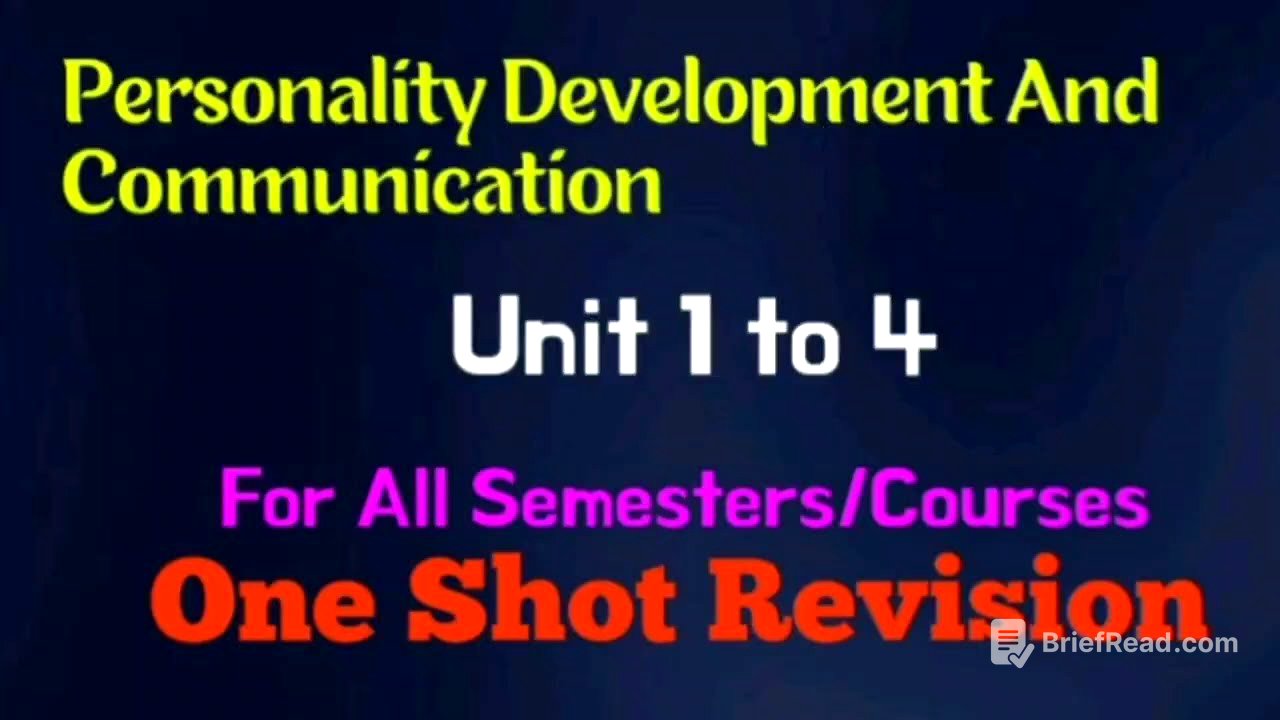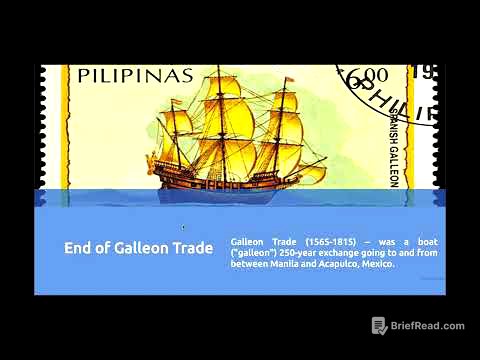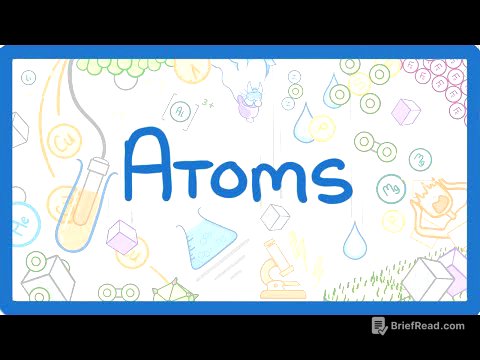TLDR;
This YouTube video provides a comprehensive one-shot revision of key communication and business concepts. It covers various aspects including the communication process, verbal and non-verbal communication, visual communication, intercultural communication, business writing, presentation skills, barriers to communication, negotiation strategies, selling skills, and the importance of emotional intelligence and teamwork. The video aims to equip viewers with essential knowledge and practical tips for effective communication and success in professional settings.
- Communication process and its needs
- Verbal, non-verbal, and visual communication
- Business writing and presentation skills
- Barriers to effective communication
- Negotiation and selling strategies
- Emotional intelligence and teamwork
Introduction [0:00]
The video starts with a welcome message and an introduction to the one-shot revision of communication topics. The presenter encourages viewers to subscribe to the channel, like the video, and share it with friends. Notes for the revision are available for purchase.
Fundamentals of Communication [0:59]
Communication involves sharing information, ideas, thoughts, and feelings between individuals and groups. It is fundamental to human integration and plays a vital role in personal relationships, business, education, and social interactions. Effective communication requires clarity, coherence, and understanding between the sender and receiver. The process includes encoding, transmitting through a channel, and decoding by the receiver to ensure the intended message is understood.
Needs of Communication [2:02]
Communication is essential for exchanging information, building relationships, expressing needs and emotions, coordinating tasks, solving problems, making decisions, and resolving conflicts. It enables individuals to share ideas, learn, and stay informed. Effective communication fosters understanding, trust, empathy, and cooperation, which are vital for personal, professional, and social relationships.
Process of Communication [4:52]
The communication process involves a sender who encodes a message (thoughts, ideas, information, feelings, or instructions) and transmits it through a chosen channel. Encoding converts the message into a transmittable form. Appropriate channels include face-to-face conversations, written documents, phone calls, emails, video conferencing, and social media. Decoding is the receiver's interpretation and understanding of the message based on their knowledge, experience, culture, and context. The receiver then provides feedback, which allows the sender to assess understanding and clarify further. Noise refers to any interference that disrupts the communication process. The context includes situational and environmental factors influencing communication. The feedback loop involves the receiver becoming the sender and vice versa, ensuring effective communication and mutual understanding.
Verbal Communication [9:31]
Verbal communication uses spoken or written words to convey messages, ideas, and information. It is a common form of communication in personal, professional, and social interactions. Types include oral communication (face-to-face conversations, phone calls, video conferencing, presentations, and discussions) and written communication (emails, letters, memos, reports, and text messages). Oral communication allows for immediate feedback, clarity through tone and non-verbal cues, and flexibility. However, it lacks a permanent record, has limited reach, and is prone to misinterpretation. Written communication provides a permanent record, clarity, precision, reach, and legal protection but suffers from delayed feedback, lack of tone, and can be time-consuming and formal.
Visual Communication [15:02]
Visual communication transmits information through visual means such as images, graphs, charts, diagrams, videos, and animations. It enhances understanding, grabs attention, is memorable, and transcends language barriers. Visual elements like logos and colors help in brand identity and recognition. Visuals help individuals process information quickly and make informed decisions. They also evoke emotions and create personal connections with the audience. Signs convey specific meanings universally within a context, while symbols represent abstract ideas and concepts, with meanings that vary culturally and contextually.
Silence as Communication [19:48]
Silence is a powerful mode of communication that conveys messages, emotions, and intentions. It allows for listening and understanding, expresses emotions, provides opportunities for reflection, and carries cultural and social significance.
Intra, Inter, and Cross-Cultural Communication [21:35]
Intra-cultural communication occurs within a single culture group, involving individuals with similar cultural backgrounds, norms, values, and communication styles. Intercultural communication involves interaction and exchange of information between individuals and groups from different cultural backgrounds. Cross-cultural communication refers to the interaction and exchange of information between individuals and groups from different cultural backgrounds, emphasizing the challenges and strategies involved in communicating across cultural boundaries.
Communication Through Questionnaires [23:15]
Communication through questionnaires involves using structured sets of questions to gather information, opinions, attitudes, and feedback. Questionnaires can be administered in various formats, including paper-based surveys, online surveys, telephone interviews, and face-to-face interviews. Benefits include structured data collection, wide reach, standardization, ease of analysis, feedback, and empowerment of respondents.
Business Letters [26:22]
Business letters are formal documents used for communication between business organizations and individuals. They follow a specific format and style, including addresses, salutations, body text, and closing remarks. Characteristics include formality, clarity, conciseness, professional formatting, politeness, correct grammar, and purposefulness.
Electronic Communication [28:47]
Electronic communication involves exchanging information, messages, and data using electronic devices and digital technology. Forms include email, instant messaging, text messaging, video conferencing, social media, and collaboration platforms.
Business Writing and Presenting [29:59]
Business presentations are formal communications designed to inform, persuade, and engage an audience in a professional setting. Effective presentations require careful planning, clear communication, and engaging delivery. Qualities of a good presentation include a clear purpose, relevance to the audience, well-structured content, compelling visuals, engaging delivery, audience interaction, adaptability, and a positive image conveyed through verbal and non-verbal cues.
Presenting a Positive Image [34:59]
Presenting a positive image through verbal and non-verbal cues is essential for creating a favorable impression and building strong relationships. Verbal cues include positive language, a warm smile, active listening, compliments, solution-focused communication, and empathy. Non-verbal cues include maintaining eye contact, positive facial expressions, open body language, purposeful gestures, appropriate proximity, and professional appearance.
Audio Visual Aids [40:03]
Audio-visual aids enhance presentations, lectures, and training sessions by incorporating visual and auditory elements. They enhance understanding, increase engagement, clarify concepts, demonstrate processes, support persuasion, facilitate collaboration, and accommodate different learning styles.
Letters Within Organizations [43:38]
Letters used within organizations include thank you letters, apology letters, resignation letters, office memorandums, and request letters. Top management uses offer letters, welcome letters, commendation letters, and termination letters. Circulars are written communications addressed to a circle of persons, while memos are internal communication modes.
Business Reports [47:23]
Business reports are formal documents that provide information, analysis, and recommendations to support decision-making. Components include a title page, executive summary, table of contents, introduction, method, findings, discussion, conclusion, recommendations, references, and appendices.
Barriers to Communication [52:33]
Barriers to communication are factors or obstacles that hinder the effective exchange of information, ideas, and messages. Types of barriers include language barriers, cultural barriers, perceptual barriers, physical barriers, emotional barriers, hierarchical barriers, semantic barriers, and information overload.
Improving Communication Skills [57:26]
Improving communication skills involves active listening, clear and concise communication, non-verbal communication, empathy, assertive communication, feedback, adaptability, and conflict resolution skills.
Non-Verbal Communication [1:01:47]
Non-verbal communication involves transmitting messages and information without words, using facial expressions, body language, posture, tone of voice, eye contact, and proximity.
Importance of Listening [1:04:55]
Listening is essential for understanding, fostering empathy, resolving conflicts, building relationships, learning, solving problems, leading effectively, and ensuring customer satisfaction.
Emotional Intelligence [1:09:31]
Emotional intelligence refers to the ability to recognize, understand, manage, and express emotions effectively. It enhances communication, promotes strong relationships, resolves conflicts, enables effective leadership, manages stress, improves decision-making, fosters adaptability, and cultivates empathy and compassion.
Working Individually vs. In a Team [1:15:43]
Individual work involves completing tasks independently, offering independence, self-reliance, focused attention, creativity, personal growth, and flexibility. Teamwork involves collaboration to achieve shared goals, requiring communication skills, collaboration skills, conflict resolution skills, leadership skills, emotional intelligence, problem-solving skills, flexibility, resilience, and time management skills.
Team Building [1:23:55]
Team building is the process of fostering collaboration, trust, communication, and cohesion among team members to achieve common goals. Effective team building involves establishing a shared vision, building trust, promoting communication, clarifying roles, embracing diversity, managing conflict, and recognizing achievements.
Interpersonal Skills [1:28:18]
Interpersonal skills enable individuals to communicate effectively, interact, and build relationships. Essential skills for a manager include expectation setting, active listening, delegation, humor, trust-building, and interpersonal compatibility.
Conflict Management [1:32:03]
Conflict management involves identifying, addressing, and solving conflicts constructively and collaboratively. Types of conflicts include interpersonal conflict, intrapersonal conflict, intergroup conflict, organizational conflict, workplace conflict, family conflict, community conflict, cultural conflict, and environmental conflict. Coping strategies include staying calm, listening actively, communicating respectfully, setting boundaries, seeking support, focusing on solutions, and practicing forgiveness.
Value of Time [1:36:02]
Time is a limited and non-renewable resource, equally distributed, with every decision involving an opportunity cost. Effective time management is essential for maximizing productivity, enhancing the quality of life, promoting personal growth, building relationships, and connecting with others.
Negotiation Skills [1:39:00]
Negotiation skills involve reaching agreements and resolving conflicts. Types of negotiation include distributive negotiation, integrative negotiation, competitive negotiation, compromising negotiation, and avoidance negotiation. Effective negotiation strategies involve defining goals, gathering information, building trust, identifying concessions, and maintaining flexibility.
Selling Skills [1:46:06]
Selling skills involve influencing customers to purchase products or services. Selling to customers involves understanding their needs, building rapport, and communicating value effectively. Selling to superiors involves persuading higher-ranking individuals to approve ideas and proposals. Selling to peer groups involves influencing colleagues and team members to support initiatives. Selling to subordinates involves motivating direct reports to support initiatives. Conceptual selling focuses on understanding and addressing customer needs through consultative solutions, while strategic selling aligns sales efforts with customer objectives and builds long-term relationships. Key body language skills include maintaining eye contact, open body posture, mirroring, smiling, purposeful gestures, and controlling nervous habits.
Conceptual and Strategic Selling [1:53:54]
Conceptual selling focuses on understanding and addressing the customer's specific needs, challenges, and objectives through a consultative, solution-oriented approach. Strategic selling involves understanding the broader context of the customer's business, aligning sales efforts with their strategic objectives, and building long-term, mutually beneficial relationships.
Body Language in Selling [1:55:58]
Effective body language in selling includes maintaining eye contact to demonstrate confidence and sincerity, using an open body posture to convey approachability, mirroring the customer's body language to build rapport, smiling genuinely to create a positive impression, using gestures purposefully to emphasize key points, maintaining good posture to project confidence, and controlling nervous habits to avoid distraction.
Conclusion [1:58:40]
The video concludes with a summary of the topics covered and an invitation to like the video and subscribe to the channel for more content.









